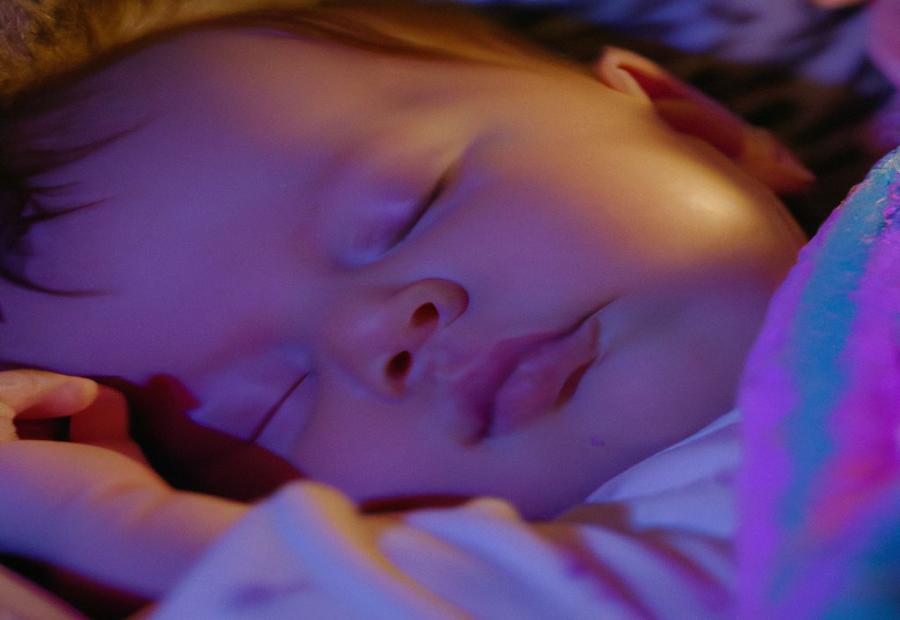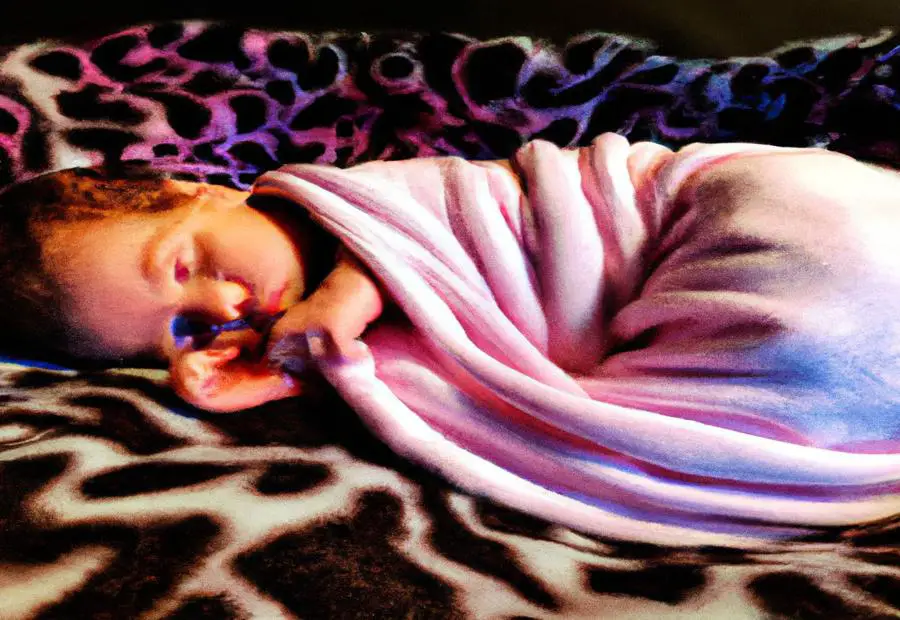Last Updated on July 12, 2023 by Francis
.jpg)
– Swaddling can be beneficial for promoting longer stretches of sleep in babies.
– It is important to stop swaddling once the baby can roll over to reduce the risk of potential hazards.
– Transition swaddles with arms free, sleep sacks that allow for full arm movement, and one-piece sleepsuits are alternatives to Love To Dream Swaddle for a rolling baby.
Contents
Introduction

Photo Credits: Meaning-Of-Number.Com by Jonathan Thomas
Swaddling is a time-honored practice that has been used to help babies sleep better for centuries. In this section, we will explore the concept of swaddling and why it is essential for promoting longer stretches of sleep for your baby. Get ready to learn about the benefits of using swaddling as a tool to create a secure and comforting environment for your little one’s slumber.
Concept of swaddling and its importance for baby sleep
Swaddling: a sleep hack that turns babies into adorable burritos and parents into sleep-deprived zombies. It’s a widely practiced technique for baby sleep, involving wrapping them snugly in a blanket or cloth. This concept has gained significance due to its positive impact on promoting better sleep. It creates a sense of security and mimics the feeling of being in the womb, helping babies feel calm and relaxed. Plus, it stops them from startling awake, and reduces fussiness and crying. Swaddling even increases breastfeeding success.
But when your baby starts rolling over, swaddling must stop. If their arms are constrained, they could suffocate if their face gets pressed against bedding. Alternatives include transition swaddles with arms free, sleep sacks, and one-piece sleepsuits. Signs it’s time to stop swaddling include increased resistance, shortened sleep durations, and if they break free from the swaddle. Always follow safe sleep guidelines to prevent SIDS.
Benefits of swaddling for promoting longer stretches of sleep
Swaddling can result in more restful sleep for babies. By wrapping securely in a blanket, it creates a safe, cozy feeling that helps them settle and relax. This can lead to longer, uninterrupted sleep.
The benefits of swaddling for better sleep are:
- Reduces startle reflex. Arms remain snug, so no flailing or waking.
- Helps self-soothing. Mimics the womb, providing a familiar, calming sensation.
- Secure sleeping environment. Feels surrounded & supported.
- Regulates temperature. Keeps warm without overheating.
- Reduces distractions. Limits movement, so they can focus on sleep.
- Enhances bonding. Parents can connect during bedtime routines.
Is it safe to use Love To Dream Swaddle when the baby can roll over?

Photo Credits: Meaning-Of-Number.Com by Austin Garcia
Using a conversational tone and relevant information from the reference data, the introduction for the section would be:
“Is it safe to use Love To Dream Swaddle when the baby can roll over? Let’s explore why swaddling should be stopped once the baby can roll over and the potential risks involved. Find out the crucial considerations to ensure your baby’s safety during this important milestone.”
Explanation of why swaddling should be stopped once the baby can roll over
Swaddling is a popular practice to ensure the baby’s comfort and security during sleep. However, once the baby can roll over, swaddling must be ceased. This is important for the baby’s safety.
Swaddling restricts the baby’s movement, which can be dangerous when they roll. The risks of continuing to swaddle a rolling baby include difficulty breathing or getting stuck in an unsafe position. So it’s essential to transition to sleepwear that gives more freedom of movement and still provides comfort and security.
Transition swaddles with arms free are a good alternative for rolling babies. These swaddles give the lower body support while allowing the arms to move. Sleep sacks and one-piece sleepsuits are also options that offer comfortable sleep and freedom to move.
Observe changes in the baby’s sleep patterns to know when to stop swaddling. If they resist being swaddled or roll onto their stomach or side during sleep, it’s time for a change. Also, if one or both arms are free after sleep despite being swaddled, it’s time to transition.
To keep babies safe during sleep, parents should follow safe sleep guidelines recommended by experts. These include putting the baby on their back on a firm surface, such as a crib mattress, without any pillows, blankets, or stuffed animals that may increase suffocation hazards. Following these guidelines and transitioning to different sleepwear can create a secure and comfortable sleep environment for babies.
Description of the potential risks of swaddling for a rolling baby
Swaddling can be risky for a rolling baby. Therefore, it should be discontinued once they start rolling over. They will not be able to move freely and this could hinder their development and increase the risk of suffocation or injury while sleeping.
Swaddling restricts babies’ movement and makes it hard for them to change positions or move around in bed. This can lead to discomfort and prevent them from getting into a comfortable sleep position. Plus, it increases the risk of positional asphyxiation if they are not able to move from that position.
Alternatives like transition swaddles, sleep sacks, and one-piece sleepsuits allow more freedom of movement and provide a safer sleep environment. It’s important to recognize when it’s time to stop swaddling. Look out for changes in their sleep patterns or increased resistance during swaddling times. Also, if the baby breaks free from the swaddle, it’s time to stop.
For the baby’s safety, it is essential to follow safe sleep guidelines. Always place them on their back on a firm surface and eliminate soft bedding such as pillows, blankets, or stuffed animals. This will reduce the potential risks associated with swaddling.
Alternatives to Love To Dream Swaddle for a rolling baby

Photo Credits: Meaning-Of-Number.Com by Logan Sanchez
When it comes to a rolling baby, finding alternatives to Love To Dream Swaddle becomes essential. In this section, we explore various options that cater to the needs of a rolling baby. From transition swaddles with arms free to sleep sacks that allow for full arm movement, and even one-piece sleepsuits for comfortable sleep, we’ll discover alternatives that prioritize safety and comfort while accommodating their new milestones.
Transition swaddles with arms free
Transition swaddles with arms free are perfect for helping babies move from being fully swaddled to having their arms free. These swaddles have adjustable wings or panels that fasten around the baby’s torso, leaving their arms out. The freedom of movement aids in physical development and prevents overheating, as babies can regulate their temperature.
Parents should carefully watch for signs of readiness before transitioning their baby. Additionally, safe sleep guidelines – such as placing the baby on their back on a firm surface and removing any soft bedding from the crib – should be followed to prevent Sudden Infant Death Syndrome (SIDS). Parents can ensure both safety and comfort for their rolling baby during sleep transitions by following these guidelines and using transition swaddles with arms free. Sleep sacks that let babies flail their arms like tiny tornadoes without getting tangled are a great option too!
Sleep sacks that allow for full arm movement
Forget the straightjackets! Parents seeking a safe and comfortable alternative to Love To Dream Swaddle once their baby starts rolling over, should opt for a cozy one-piece sleepsuit.
Sleep sacks with full arm movement offer parents the security of being covered while still allowing the baby to move freely. These sleep sacks have become increasingly popular as awareness grows about safe sleep practices. They provide a secure environment while allowing arm movement, making them a practical solution for parents seeking safe sleepwear options.
Sleep sacks offer adjustable closures, breathable fabric, and roomy designs, so babies can kick and stretch comfortably while still being securely contained. Plus, with the ability to move their arms, babies can explore self-soothing techniques such as thumb sucking or reaching for a pacifier, promoting better sleep habits.
In short, sleep sacks that allow for full arm movement offer an ideal transition aid when transitioning from swaddling, supporting the baby’s changing developmental needs.
One-piece sleepsuits as an option for comfortable sleep
One-piece sleepsuits make a great choice for comfortable sleep for babies. Full body coverage, no extra layers of clothing, soft and breathable fabric, unrestricted movement – these sleepsuits have it all! Plus, they are easy to put on and take off, and come in various designs and styles.
Research by pediatric experts suggests that one-piece sleepsuits provide a cozy and secure sleep environment for babies. Say goodbye to swaddling and hello to comfy sleepwear!
Signs that it’s time to stop swaddling and transition to other sleepwear

Photo Credits: Meaning-Of-Number.Com by Peter Ramirez
It’s essential to know when it’s time to stop swaddling your baby and transition to other sleepwear. In this section, we’ll explore significant signs that indicate the need for a swaddling transition. From observing changes in sleep patterns to recognizing the baby’s ability to roll over and resist swaddling, and even finding the baby with one or both arms free after sleep, these signs will help guide parents towards making the right decision for their little ones.
Observing changes in the baby’s sleep patterns
When watching for changes in a baby’s sleep routine, pay close attention to any variations. Babies develop and their sleep patterns evolve. These changes can be in the length of their sleep cycles, adjustments in nap times, or different nighttime routines. Close monitoring gives valuable insights into their development and sleep-related issues.
It is essential to understand these changes for providing the right care and support for the baby’s wellbeing. Keeping an eye out for shifts in sleep patterns helps identify if the baby is uncomfortable. This can lead to interventions or changes in bedtime to improve their sleep quality.
Other signs of potential issues with sleep include: excessive fussiness or irritability when waking up, difficulty falling asleep or staying asleep, inconsistent napping, or frequent night time awakenings. Knowing these patterns allows parents to address any factors that might be disrupting the baby’s sleep.
By observing changes and promptly addressing any concerns, parents can establish healthy sleeping habits early on. This benefits their physical growth, cognitive development, and creates a good relationship with sleep as they get older. Monitoring the baby’s sleep plays an important role in promoting their overall wellbeing and optimal rest for them and their caregivers.
Recognizing the baby’s ability to roll over and resist swaddling
Watch for changes in the baby’s movements during sleep. Signs of resistance when trying to swaddle, like fussiness or wriggling, could signal a need for a new sleepwear option. If you notice your baby is consistently rolling from back to front or front to back, it’s a sign they can change positions on their own.
Be on the lookout for changes in sleep patterns, like waking more often or difficulty settling while swaddled. Observe safe sleep guidelines to decrease the risk of SIDS: put babies on their backs on firm surfaces, and keep cribs free from soft bedding and other items.
If you find your baby with one or both arms free after sleep, it could mean the Love To Dream Swaddle is no match for their tiny Houdini skills. Adapt and prioritize comfort and safety – it’s time to ensure a safer sleep environment.
Finding the baby with one or both arms free after sleep
Swaddling can help babies sleep longer. But when is it time to stop? One sign is when a baby has one or both arms free after sleep. Here’s how to identify this sign and know when to switch:
- Check their sleeping position: After sleeping, check if they have freed their arms from the swaddle.
- Note any changes in sleep patterns: If there’s more movement or restlessness, it could mean they’re trying to break free.
- Note resistance to swaddling: As they grow, they may resist being wrapped tightly. If they wiggle out or get fussy, it might be time for a change.
- Consider age and development: Once they can roll over independently, swaddling can be risky because it restricts arm movement.
- Evaluate safety risks of continuing to swaddle: Swaddling increases the chances of ending up in an unsafe position.
- Explore alternative sleepwear options: Transition swaddles with arms free, sleep sacks, and one-piece sleepsuits are all safe and comfy options.
Safety and comfort are key when transitioning. Recognizing the signs of when to stop swaddling helps parents make the best decisions for their baby.
Importance of following safe sleep guidelines to prevent SIDS

Photo Credits: Meaning-Of-Number.Com by Robert Martin
Following safe sleep guidelines is crucial in preventing Sudden Infant Death Syndrome (SIDS). In this section, we’ll explore two important aspects: placing the baby on their back on a firm surface and eliminating soft bedding and other items in the crib. Stay informed on these guidelines to ensure a safe sleep environment for your baby.
Placing the baby on their back on a firm surface
Swaddling a baby and putting them on their back on a solid surface is significant for safe sleep practices. This position aids in lessening the danger of Sudden Infant Death Syndrome (SIDS) and encourages proper airflow and breathing. It is pivotal to comply with this rule to form a secure sleep environment for the baby.
- Put the baby on their back: Make sure that the baby is put on their back when they are laid down to sleep. This stance is recommended by pediatricians as it decreases the risk of suffocation and enables optimal breathing.
- Use a firm surface: The infant should be put on a sturdy mattress or surface when sleeping. Soft surfaces, such as pillows or fluffy mattresses, can increase the hazard of suffocation or accidental roll-overs. A crib with a fitted sheet is perfect for providing a protected and secure sleeping atmosphere.
- Use a sleep sack or swaddle: To keep the baby comfortable and safe while they sleep on their back, parents can use a sleep sack or swaddle that allows for suitable hip movement while holding arms in. These items provide warmth without covering the face or hindering breathing.
- Keep bedding limited: Limiting bedding in the crib is fundamental to lower the risk of suffocation or entanglement hazards. Dodge using blankets, pillows, stuffed animals, or other unsecured items in the crib to make sure a safe sleeping space.
- Stay consistent: It is vital to continually put the baby on their back throughout each sleep session until they have obtained sufficient neck control to change positions autonomously. Keeping up with this convention boosts safe sleep habits and reduces the risk of accidents during naptime or nighttime rest.
Placing the baby on their back on a firm surface not only decreases SIDS risks but also helps in better overall safety during sleep. Adhering to these key points will aid in crafting an ideal sleeping atmosphere for infants while ensuring peace of mind for parents or caregivers.
Eliminating soft bedding and other items in the crib
Don’t use blankets or pillows in the crib. Also, no stuffed animals or bumpers! Make sure the mattress is firm and fits exactly. Pick a fitted sheet that covers the mattress tightly with no extra fabric. No sleep positioners or wedges either. Keep the crib clear of cords, wires, and other unsafe items.
It’s important to prioritize safe sleep guidelines. Put the baby on their back on a firm surface and remove soft bedding and other items from the crib. Make sure there are no toys or extra clothing that could block the baby’s airway.
Creating a safe sleep environment is key for healthy sleep and minimal risks for babies. Inspect the crib often for loose screws or broken parts to add extra safety.
Conclusion: Ensuring the baby’s safety and comfort during sleep transitions

Photo Credits: Meaning-Of-Number.Com by Peter King
Ensuring a baby’s safety and comfort during sleep transitions is essential. Regarding the Love to Dream Swaddle, it does not explicitly state if it can be used when the baby can roll over.
However, for safety, stop using swaddles when they can roll over. This suggests they are developing motor skills for independent movements and swaddling may cause suffocation or hindering development.
The Swaddle’s purpose is to provide comfort and secure sleep. It supports babies’ natural sleeping position with arms up, allowing self-soothing and reducing the startle reflex. Still, safety needs to come first and adapt to changing needs.
Caregivers can introduce other sleep solutions, such as sleep sacks or wearable blankets, for more movement freedom. These provide security and warmth without inhibiting rolling over.
To wrap up, prioritize safety when babies reach milestones like rolling, and adapt to their changing needs. Doing this is important for their well-being and development.
Some Facts About Using Love To Dream Swaddle When Baby Can Roll Over:
- ✅ Love To Dream Swaddle should not be used once the baby can roll over on their own, as it can restrict their movement and pose a suffocation risk. (Source: Team Research)
- ✅ It is important to transition out of swaddling when the baby shows signs of wanting to change position and roll over. (Source: Team Research)
- ✅ Sleep sacks are a safe alternative to swaddling for babies who can roll over, as they allow for full arm movement and freedom of movement in the lower body. (Source: Team Research)
- ✅ Signs that it’s time to stop swaddling include the baby not sleeping as well, rolling over when not swaddled, finding the baby with one or both arms free after sleep, and the baby resisting swaddling. (Source: Team Research)
- ✅ The age at which babies start rolling over can vary, but it is generally around 4 to 6 months. (Source: Team Research)
FAQs about Can You Use Love To Dream Swaddle When Baby Can Roll Over
Can you use Love To Dream Swaddle when baby can roll over?
It is not recommended to use the Love To Dream Swaddle or any swaddling product once the baby can roll over on their own. Swaddling can restrict their movement and pose a suffocation risk. It is important to transition out of swaddling when the baby shows signs of wanting to change position and roll over.
What are the alternatives to swaddling?
Alternatives to swaddling include using a transition swaddle with arms free, a sleep sack with arms out, or a one-piece sleepsuit. These options allow for full arm movement and freedom for the baby to roll over safely.
Is it safe to use the Love To Dream Swaddle Up for a 4-month-old baby?
For babies older than 4 months or who can roll over, it is no longer safe to swaddle. It is recommended to use a sleep sack with arms out instead, such as the Love To Dream Swaddle Up Transition Sleep Sack with Zip-Off Wings.
Are there any added hours of sleep when using the Love To Dream Swaddle?
The Love To Dream Swaddle, with its unique design of allowing babies to have their arms up, can lead to longer stretches of sleep. However, the amount of sleep gained can vary for each baby.
Can I use the Love To Dream Swaddle for newborns?
The Love To Dream Swaddle UP is recommended for newborns. It provides a snug feeling for them and allows their arms to be up, which can promote better sleep.
Can I use the Love To Dream Swaddle for babies who tend to crawl around or stand up?
Yes, the Love To Dream Swaddle can still be used for babies who like to crawl around or stand up. Its design allows for some freedom of movement while providing a secure feeling.





